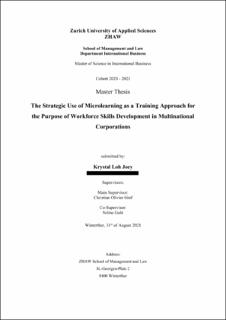Please use this identifier to cite or link to this item:
https://doi.org/10.21256/zhaw-24663Full metadata record
| DC Field | Value | Language |
|---|---|---|
| dc.contributor.advisor | Graf, Christian Olivier | - |
| dc.contributor.advisor | Guhl, Selina | - |
| dc.contributor.author | Loh Joey, Krystal | - |
| dc.date.accessioned | 2022-03-28T13:22:48Z | - |
| dc.date.available | 2022-03-28T13:22:48Z | - |
| dc.date.issued | 2021 | - |
| dc.identifier.uri | https://digitalcollection.zhaw.ch/handle/11475/24663 | - |
| dc.description.abstract | The rapid pace of digital disruption aggravated by socio-demographic trends have impacted the nature of work tremendously. The skills that multinational corporations (MNCs) value and relied upon have been evolving faster than ever. Hence, learning and development (L&D) has been finding new ways to help their workforce keep up with the shifting skills needs. However, there have been numerous issues with traditional training for skills development, including considerable financial and time investments that may interfere with a company's daily operations. As a result, an increasing trend toward technology-enabled learning, such as microlearning, has aided MNCs in quickly filling skill gaps. The aim of this thesis was to shed light on the emerging topic of microlearning in hopes of paving the way for future research. With many L&D professionals still unfamiliar with the present state of microlearning, they would have been even far less aware of the factors to implement it successfully within their organizations. This research also took on the strategic lens in examining the role of strategic human resource management (SHRM) and organizational learning (OL) through the perspective of L&D professionals. Four research objectives have also been of particular interest throughout this thesis. In order to fulfill the research question and stated objectives, this research adopted a qualitative research design of an exploratory nature. Semi-structured interviews were conducted with six L&D professionals. There were two categories of L&D experts interviewed: those with strategic level experience and those with systems or operational level expertise. The results showed that L&D professionals agreed that SHRM and OL serve as a sources of competitive advantage. The conducted research also revealed that OL is not only a competitive advantage, but also a survival strategy, as it aids the firm in adapting to its ever-changing business environment. The findings also indicated that L&D is seen as a strategic enabler. The results gathered that the most critical skills gap is the need to enable employees to take care of their continuous self-development. By combining the information from the literature review with the findings from the interviews, five main drivers for the adoption of microlearning emerged. Likewise, this thesis also presented five main features that distinguish microlearning as an effective training approach for skills development. Taking into account the study's limitations, the findings led to recommendations for L&D professionals on nine multi-dimensional success factors for the implementation of microlearning. While L&D has a crucial role to play in the success of an organization’s training strategy and approach, it also demands significant buy-in and participation from top management, line management, and every single employee. Ultimately, every single learner should be responsible for his or her continuous self-development in order for the organization to gain a competitive advantage through its human capital. | de_CH |
| dc.format.extent | 159 | de_CH |
| dc.language.iso | en | de_CH |
| dc.publisher | ZHAW Zürcher Hochschule für Angewandte Wissenschaften | de_CH |
| dc.rights | https://creativecommons.org/licenses/by-nc-nd/4.0/ | de_CH |
| dc.subject.ddc | 658.3: Personalmanagement | de_CH |
| dc.title | The strategic use of microlearning as a training approach for the purpose of workforce skills development in multinational corporations | de_CH |
| dc.type | Thesis: Master | de_CH |
| dcterms.type | Text | de_CH |
| zhaw.departement | School of Management and Law | de_CH |
| zhaw.publisher.place | Winterthur | de_CH |
| dc.identifier.doi | 10.21256/zhaw-24663 | - |
| zhaw.originated.zhaw | Yes | de_CH |
| Appears in collections: | MSc International Business | |
Files in This Item:
| File | Description | Size | Format | |
|---|---|---|---|---|
| Loh_Krystal_W.MA.IB.pdf | 1.96 MB | Adobe PDF |  View/Open |
Show simple item record
Loh Joey, K. (2021). The strategic use of microlearning as a training approach for the purpose of workforce skills development in multinational corporations [Master’s thesis, ZHAW Zürcher Hochschule für Angewandte Wissenschaften]. https://doi.org/10.21256/zhaw-24663
Loh Joey, K. (2021) The strategic use of microlearning as a training approach for the purpose of workforce skills development in multinational corporations. Master’s thesis. ZHAW Zürcher Hochschule für Angewandte Wissenschaften. Available at: https://doi.org/10.21256/zhaw-24663.
K. Loh Joey, “The strategic use of microlearning as a training approach for the purpose of workforce skills development in multinational corporations,” Master’s thesis, ZHAW Zürcher Hochschule für Angewandte Wissenschaften, Winterthur, 2021. doi: 10.21256/zhaw-24663.
LOH JOEY, Krystal, 2021. The strategic use of microlearning as a training approach for the purpose of workforce skills development in multinational corporations. Master’s thesis. Winterthur: ZHAW Zürcher Hochschule für Angewandte Wissenschaften
Loh Joey, Krystal. 2021. “The Strategic Use of Microlearning as a Training Approach for the Purpose of Workforce Skills Development in Multinational Corporations.” Master’s thesis, Winterthur: ZHAW Zürcher Hochschule für Angewandte Wissenschaften. https://doi.org/10.21256/zhaw-24663.
Loh Joey, Krystal. The Strategic Use of Microlearning as a Training Approach for the Purpose of Workforce Skills Development in Multinational Corporations. ZHAW Zürcher Hochschule für Angewandte Wissenschaften, 2021, https://doi.org/10.21256/zhaw-24663.
Items in DSpace are protected by copyright, with all rights reserved, unless otherwise indicated.